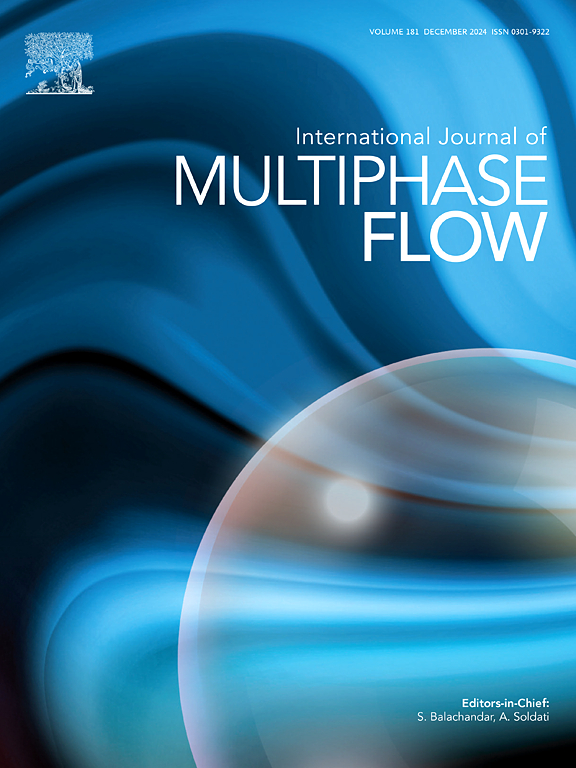Effects of Weber number and hole location on subcritical curtain flow regimes
IF 3.6
2区 工程技术
Q1 MECHANICS
International Journal of Multiphase Flow
Pub Date : 2025-02-06
DOI:10.1016/j.ijmultiphaseflow.2025.105163
引用次数: 0
Abstract
The flow regimes of a gravitational plane liquid jet (curtain) issuing into a quiescent gaseous ambient are investigated in subcritical conditions, namely for inlet Weber number . By means of three-dimensional direct numerical simulations based on the volume-of-fluid method, steady curtain base flow solutions are obtained and excited by introducing hole perturbations, whose evolution is assessed by variation of and (i.e. the hole initial location) parameters. Depending on the combination of and , three different flow regimes are observed. In the sheet (S) regime, the hole perturbation expands in the curtain and is convected downstream, generating secondary holes washed out at the domain outflow, leaving the curtain intact. In the transient columns (TC) regime, the secondary holes expand and merge with the primary hole, generating vertical liquid ligaments (columns) expelled from the domain in finite time, leaving the curtain again in its original state. In the columns (C) regime, the curtain finally exhibits a transition from the continuous sheet shape to a discrete permanent (i.e. stationary) columns pattern. The phase diagram of the curtain flow is drawn by representing all numerical results in the parameters space -. It is found that the S, TC and C regimes are clustered into three distinct regions of the diagram by two theoretical curves, namely and , where : for , the curtain is in the S regime; for , the TC regime is obtained; for , the curtain experiences a permanent rupture migrating to the C regime. The curve represents the celebrated critical station, namely the streamwise location along the curtain where the local Weber number is equal to unity, and was derived in previous literature within the simplified inviscid one-dimensional flow assumption. The curve is here denoted as the breakup station, since for the curtain undergoes permanent rupture, driven by the upstream retraction of the hole due to surface tension. It is found that for . Therefore, the breakup Weber number found here () represents the maximum at which the curtain transition from the sheet (S) to the columns (C) regime can be observed. The classifier role played by the theoretical 1D curves in clustering the numerical 3D phase diagram provides a connection between simplified linear one-dimensional theories and fully three-dimensional simulations of curtain flows.

求助全文
约1分钟内获得全文
求助全文
来源期刊
CiteScore
7.30
自引率
10.50%
发文量
244
审稿时长
4 months
期刊介绍:
The International Journal of Multiphase Flow publishes analytical, numerical and experimental articles of lasting interest. The scope of the journal includes all aspects of mass, momentum and energy exchange phenomena among different phases such as occur in disperse flows, gas–liquid and liquid–liquid flows, flows in porous media, boiling, granular flows and others.
The journal publishes full papers, brief communications and conference announcements.

 求助内容:
求助内容: 应助结果提醒方式:
应助结果提醒方式:


